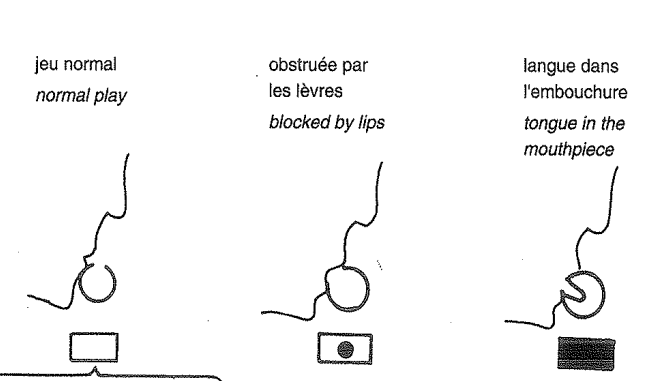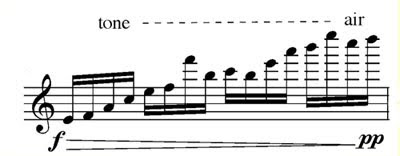Here are some tips on the use of air or aeolian sounds:
Be sure to specify if you want these sounds:
A. produced in normal playing position, so the air goes across the flute and produces a pitch that corresponds with the fingers (pitched air / aeolian sound), or
B. produced inside the flute: i.e., if you want the flutist to cover the embouchure hole and produce a kind of unpitched “white noise”.
Here are the symbols showing different embouchure positions from “Flutes au Present” by P. Y. Artaud. Sometimes I have seen the last one (the completely filled rectangle) to generally mean any technique that requires a covered embouchure hole. In Helmut Lachenmann’s music, he uses a filled-in rectangle as a note head to indicate a covered embouchure. A filled-in circle over a note can also indicate a closed embouchure hole – see below.

Sometimes I am asked to produce type “A” with the specification “no discernible pitch”. This is nonsense: if a flutist blows across the flute they will always produce some sort of pitch. Even with no fingers down, you will get something in the neighborhood of C#. If you want pitched air and feel the need to add written instruction, just write “only air”. If you want unpitched noise, ask the flutist to blow into or inside the flute (cover the embouchure hole). In this position, the flutist can produce a range of unpitched sounds from bright (higher sounding white noise) to dark (lower sounding pink/brown noise) by changing the position of the tongue (changing the vowel shape).
This leads to my next point: the use of different vowel sounds for color effects. This is most effective with the embouchure hole covered (type “B”). A good use of covered vowels can be found in Hans Zender’s Lo-Shu II. Be aware that vowel sounds are much less marked in normal playing position (type “A”). Vowel changes in normal playing are not very discernible. See my tutorial here where I go into more detail.
Some general thoughts about notation:
There are several notational traditions from the Artaud and Levine books concerning the notation of “aeolian” or “air” sounds which I would like to ask composers to avoid. When composing these sounds especially in a situation where rhythm is crucial (especially in an ensemble situation) please avoid the notation that uses empty note-heads*:

This notation makes the distinction between a quarter note and a half note difficult. When a player is reading, this can be very annoying. It’s good to have a different note shape, but be sure to fill in the note head in when needed so the player can read the rhythms easily:

An easy way to indicate a gradual change from normal sound to air is by using text with a dotted line:

or simply with a filled circle connected to an open circle by a dotted line:

* Using empty note heads under a tuplet is less problematic and in most cases acceptable
Leave a Reply